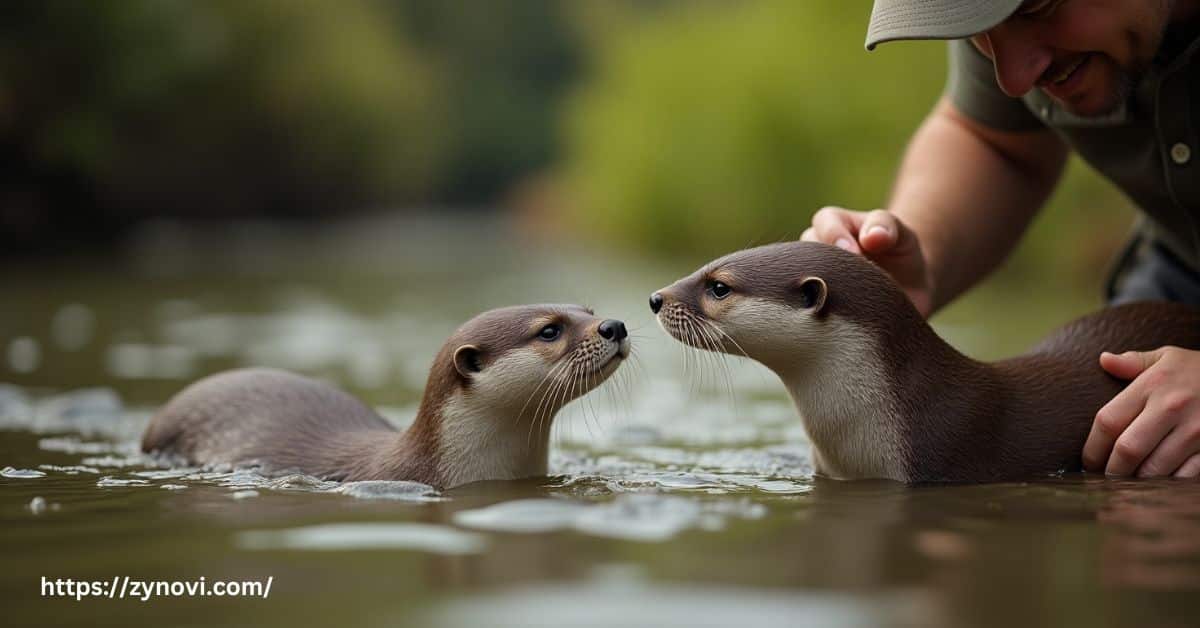Do Otters Attack Humans? They rarely attack, but incidents can occur if they feel threatened or provoked, in defense of their young.
Otters are often seen as adorable, playful aquatic mammals, but there is a lesser-known side to their behavior that might surprise you. Otter attacks can rare occur, and understanding the risks, their behavior, and how to stay safe is essential for anyone who enjoys spending time near rivers, lakes, or coastal waters.
In this comprehensive guide, we will explore the fascinating world of otters, their habits, and what makes these creatures sometimes aggressive. From their natural habitats to their social behavior, we will also find out practical tips to avoid dangerous otter interactions and protect both yourself and these remarkable animals.
Do Otters Attack Humans? Understanding Otters
What Are Otters?
Otters are semi-aquatic mammals belonging to the Mustelidae family, which includes weasels, badgers, and ferrets. There are 13 species of otters globally, with the river otter and sea otter being the most well-known.
Types of Otters
- River otters (Lontra canadensis): Found in freshwater rivers and lakes across North America, these otters are adept swimmers and rely on aquatic habitats for hunting and shelter.
- Sea otters (Enhydra lutris): Native to coastal areas of the North Pacific Ocean, sea otters are known for their thick fur and reliance on kelp forests for survival.
- Eurasian otters (Lutra lutra): Widespread across Europe and Asia, these otters adapt to a variety of habitats, from rivers to coastal regions, showcasing remarkable versatility.
These animals are characterized by their streamlined bodies, webbed feet, and thick waterproof fur, which help them thrive in aquatic environments.
Physical Characteristics and Habitat
Otters are built for life in water:
| Feature | Purpose |
|---|---|
| Thick waterproof fur | Insulation in cold water |
| Webbed feet | Efficient swimming |
| Muscular tails | Steering and propulsion |
| Streamlined bodies | Reduced drag while swimming |
They are commonly found in:
- Freshwater rivers, streams, and lakes: These habitats provide an abundant supply of fish and other aquatic prey, making them ideal for otters. Riverbanks often serve as nesting and resting areas.
- Wetlands and marshy areas: These areas offer dense vegetation and shallow waters, which are perfect for foraging and hiding from predators. Wetlands are also crucial for breeding and raising young otters.
- Coastal regions and estuaries: Coastal environments provide rich feeding grounds, especially for sea otters, which thrive on shellfish and other marine life. Estuaries often serve as transition zones for otters between freshwater and saltwater habitats.
- Urban environments: Surprisingly, otters adapt well to urban settings near water. They are frequently spotted in city rivers, canals, and ponds, where they coexist with humans despite the challenges of pollution and habitat loss.
Urban environments near water bodies sometimes attract otters, leading to increased human-wildlife interaction.
Typical Behavior and Diet
- Otters exhibit a mix of playful and practical behaviors that reflect their adaptability and intelligence. They are famously known for their playful activities, such as sliding on mud or snowbanks, which are thought to be both recreational and a means of improving coordination.
- Despite their playful nature, otters are highly territorial creatures, often defending their domains from intruders, including other otters. This territoriality becomes even more pronounced during the breeding season, when mothers fiercely protect their young from potential threats.
- Their behavior is a blend of social interaction, survival instincts, and environmental adaptation.
Their diet primarily consists of:
- Fish: The staple of an otter’s diet, providing essential nutrients for energy and growth.
- Crustaceans: Such as crabs and shrimp, which they catch with precision in shallow waters.
- Amphibians: Including frogs and salamanders, adding variety to their diet when fish is scarce.
They exhibit tool use in animals, such as breaking open shellfish with rocks, showcasing their remarkable intelligence and adaptability in the wild.
Do Otters Pose a Threat to Humans?

Frequency of Human-Otter Interactions
Are Otters Dangerous? While otters rarely attack humans, interactions are increasing due to habitat encroachment and human activities in otter habitats. Documented cases include:
- A kayaking incident in Florida: In this case, a group of paddlers was startled when an otter suddenly attacked their kayaks, causing minor injuries and damaging equipment.
- A tubing incident in Washington: Swimmers faced an aggressive otter that lunged and bit at them, leading to a rapid retreat to safety and subsequent medical attention for minor wounds.
Reasons Behind Otter Aggression
Are otters aggressive towards humans? Otter aggression is typically driven by:
- Territorial behavior: Otters are highly territorial creatures, especially in areas with limited food or space. They may attack intruders, including humans, to protect their range.
- Protective instinct: During the breeding season, otters are fiercely protective of their young and will become aggressive if they perceive a threat to their offspring.
- Human provocation: Accidental actions such as approaching too closely, feeding them, or disturbing their food sources can trigger defensive or aggressive responses from otters.
- Are River Otters Aggressive? River otters are generally not aggressive toward humans unless they feel threatened. However, they can exhibit defensive behavior if their territory or young are disturbed, especially during the breeding season.
How Dangerous Are Otter Attacks?

Severity of Injuries
Do otters attack humans? Although most otter attacks result in minor injuries, severe cases have been reported:
- Bites and scratches: Otter bites are often deep and painful due to their sharp teeth, capable of puncturing skin and causing significant bleeding.
- Trauma: In rare cases, prolonged encounters with aggressive otters can lead to severe physical harm, including deep lacerations and potential fractures.
Hidden Health Risks from Otters
Otters can carry diseases and bacteria, posing health risks to humans:
| Health Risk | Description |
|---|---|
| Rabies risk | Rare but possible; otters can transmit rabies. |
| Pasteurella multocida | Common bacterium found in animal bites. |
| Leptospirosis | Bacterial infection from contact with otter urine. |
Prompt medical attention is crucial after any aggressive encounter.
Preventing and Managing Otter Encounters
Respecting Otter Territories
To minimize risks, it’s essential to respect otter habitats:
- Avoid approaching dens or areas with scent marking: Otter dens are their safe zones, and scent markings serve as warnings to other animals. Intruding into these areas can provoke defensive aggression.
- Stay clear of groups with young otters, especially during breeding season: Female otters are particularly protective of their pups. Approaching too closely can be seen as a threat, leading to aggressive behavior.
What to Do When Confronted by an Aggressive Otters attack humans?
Encountering an aggressive otter can be alarming. Here’s how to stay safe:
- Stay calm: Avoid sudden movements that may escalate aggression. Remaining composed helps reduce the likelihood of provoking the otter further, allowing you to assess the situation.
- Back away slowly: Do not turn your back or run, as sudden actions can trigger the otter’s chase instinct. Gradually increasing the distance helps de-escalate the encounter.
- Use noise-making devices: Clap, shout, or use a whistle to deter the animal. Loud noises often startle otters, giving you an opportunity to retreat to safety.
Proactive Steps to Avoid Encounters
Preventive measures can greatly reduce the risk of otter attacks:
- Keep pets leashed near water: Unleashed pets may provoke otters, either by entering their territory or appearing as predators. Keeping pets restrained ensures their safety and avoids unnecessary encounters.
- Avoid feeding or attempting to touch otters: Feeding wild animals can make them overly familiar with humans, increasing the likelihood of aggressive interactions. Maintaining a safe distance is crucial for both humans and otters.
- Carry a stick or whistle during outdoor activities near otter habitats: These tools can be used to scare off otters if they approach too closely, providing an effective way to prevent escalation.
FAQs
Will Otters Attack Dangerous to Humans?
While otters are generally not a threat, they can become dangerous under certain conditions, such as defending their territory.
What Should You Do if an Otter Approaches?
Remain calm, back away slowly, and avoid making direct eye contact.
Can Otter Bites Lead to Infections?
Yes, otter bites can cause serious infections, including Pasteurella multocida and leptospirosis. Immediate medical attention is necessary.
How Can You Identify are otters aggressive towards humans?
Signs of aggression include:
- Loud vocalizations
- Raised fur
- Charging or lunging behavior
Do Otters Attack Pets?
Yes, otters have been known to attack pets, particularly dogs, if they perceive them as a threat.
Are River Otters More Aggressive Than Sea Otters?
River otters are generally more territorial due to their habitat’s limited resources, making them more likely to exhibit aggression.
Conclusion: Do Otters Attack Humans?
Otters are fascinating creatures with complex social behaviors and a generally playful nature. However, understanding their territorial instincts and respecting their habitats is key to avoiding dangerous otter interactions. Although otter attacks are rare, they can result in injuries and potential health risks if precautions are not taken.
By maintaining a safe distance, respecting their natural spaces, and staying informed about their behaviors, you can enjoy observing these remarkable aquatic mammals without conflict. Whether you’re a kayaker, a nature enthusiast, or someone who frequents otter habitats, taking simple steps to coexist peacefully ensures both your safety and the well-being of these animals.
Otters are a vital part of aquatic ecosystems, and appreciating them from a distance is the best way to foster harmony between humans and wildlife.










